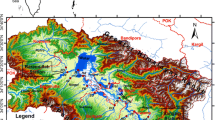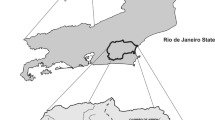Abstract
The study of hydrochemical variations and water quality assessment of the Euphrates river was performed in eight water points and two rainfall sites, during a boundary condition of rainy weather. The hydrochemical variations are determined, using the analysis results of 14 physico-chemical variables in 26 water samples. The study examined the depletion and attenuation processes during a rainstorm and the re-enrichment of the concentrations after rain event by using the statistical information of the major ions (HCO3−, SO4−2, Cl−, Mg+2, Ca+2, Na+, and K+). The lowest values of Cl−, SO4−2 were observed (94.7 and 202 mg/L) during the rain storm period, while the highest value of Cl− (114 mg/L) and SO4−2 (254 mg/l) were recorded before and after rain storm, respectively. The values K+, Na+, Mg+2, and Ca+2 are (3.3, 73.5, 35.8, and 83 mg/L). The hydrogeochemical indices confirm the role of irregular processes of chemical balance resulting from the propagation of mixing, ion exchange, and water-rock interaction between river and rainstorm water during high flow period. The results that derived from water quality assessment indicate that there are no serious geogenic pollution cases, with the absence of thermal pollution sources which is degradation of water quality by any process that changes ambient water temperature such as domestic sewage, hot springs, and soil erosion that forms serious impact on the biological diversity of the Euphrates water system. The total dissolved solids (TDS) and electrical conductivity (EC) measurements ranging from 484 to 778 mg/L and from 770 to 985 μScm−1, respectively.









Similar content being viewed by others
References
Al-Hamdani M, Al-Dulaymi A, Hussien B (2012) Sources of ions and trace elements in the water of Euphrates river from Qaem to Baghdadi (statistical study). Iraqi Bulltin of Geology and Mining 8:1811–4539
Al-Jabbari M, Hassen Q, Emad M (2002) National programme in the best used of water resources within Euphrates basin. Unpub. Study. Ministry of Agriculture, Baghdad, p 520
Al-Janabi M (2008) Qualitative and environmental study for Euphrates river from Dyer Elzor to Baghdadi, using chemical analysis and remote sensing. Thesis, Science College, Anbar University, Unpub (in Arabic)
Al-Sudani HI (2018) Calculating of groundwater recharge using meteorological water balance and water level fluctuation in Khan Al-Baghdadi area. Iraqi Journal of Science 59:349–359
Altoviski M (1962) Handbook of hydrogeology. Gosgeolitzdat, Moscow, USSR, p 614
Amiri V, Berndtsson R (2020) Fluoride occurrence and human health risk from groundwater use at the west coast of Urmia Lake, Iran. Arab J Geosci 13:1–23
Amiri V, Rezaei M, Sohrabi N (2014) Groundwater quality assessment using entropy weighted water quality index (EWQI) in Lenjanat, Iran. Environ Earth Sci 72:3479–3490
Amiri V, Sohrabi N, Dadgar MA (2015) Evaluation of groundwater chemistry and its suitability for drinking and agricultural uses in the Lenjanat plain, central Iran. Environ Earth Sci 74:6163–6176
Amiri V, Nakhaei M, Lak R, Kholghi M (2016) Assessment of seasonal groundwater quality and potential saltwater intrusion: a study case in Urmia coastal aquifer (NW Iran) using the groundwater quality index (GQI) and hydrochemical facies evolution diagram (HFE-D). Stoch Env Res Risk A 30:1473–1484
Amiri V, Kamrani S, Ahmad A, Bhattacharya P, Mansoori J (2020) Groundwater quality evaluation using Shannon information theory and human health risk assessment in Yazd province, central plateau of Iran. Environmental Science and Pollution Research p:1–23
Appelo CAJ, Postma D (2005) Geochemistry, groundwater and pollution, 2nd edn. Balkema, Rotterdam
Ayers R, Westcot D (1985) Water quality for agriculture, FAO irrigation and drain, Paper No. 29, Rev 1, Food and Agriculture Organization of the United Nations Rome p 1-109
Canadian Council of Minister of the Environment (CCME) (2001) Canadian water quality guidelines for the protection of aquatic life: CCME water quality index 1.0, Technical Report. Canadian Council of Ministers of the Environment Winnipeg MB, Canada
Chadha DK (1999) A proposed new diagram for geochemical classification of natural waters and interpretation of chemical data. Hydrogeol J 7(5):431–439
Collin’s, A.G (1975) Geochemistry of oil field water. Development in Petroleum science-1, Holl-and p 496.
Crist MA, Lowry ME (1972) Groundwater resource of Natrona county Wyming. In: A study of the availability and chemical quality of groundwater, GS Water Supply paper 1897. US. Government printing office, Washington, p 92
Esmaeili-Vardanjani M, Rasa I, Amiri V, Yazdi M, Pazand K (2015) Evaluation of groundwater quality and assessment of scaling potential and corrosiveness of water samples in Kadkan aquifer, Khorasan-e-Razavi Province, Iran. Environ Monit Assess 187:53
Fayyadh AS, Bayan M, Hussien BM, Al-Hamdani MA, Salim SA, Mukhlef HN, Abed MA (2016) Hydrologic system of Euphrates river (spatial analyses) between Al-Qaem and Fallja. Iraqi Bulltin of Geology and Mining 12:1–118
Fitts C (2002) Groundwater science. Elsevier Science. Ltd, p 450
Golekar R, Baride M, Patil S (2014) Geomedical health hazard due to groundwater quality from Anjani-Jhiri River Basin, Northern Maharashtra, India. Int ResJ Earth Science 2:2321–2527
Guey-Shin S, Bai-You C, Chi-Ting C, Pei-Hsuan Y, Tsun-Kuo C (2011) Applying factor analysis combined with kriging and information entropy theory for map** and evaluating the stability of groundwater quality variation in Taiwan. Int J Environ Res Public Health 8:1084–1109
Helsel D, Hirsch R (2002) Statistical methods in water resources, chapter A3. Techniques of waterresources investigations of the US Geological Survey, Book 4
Hem, J., 1989; Study and interpretation of the chemical characteristics of natural water, 3rd. edition USGS Water Supply. Paper 2254, p 263.
Hussien BM, Faiyad AS (2016) Modeling the hydrogeochemical processes and source of ions in the groundwater of aquifers within Kasra-Nukhaib region (West Iraq). Int J Geosci 7:1156–1181
Issa IE, Al-Ansari N, Sherwany G, Knutsson S (2014) Expected future of water resources within Tigris-Euphrates rivers basin, Iraq. Journal of Water Resource and Protection 6:421–432
Jankowski J, Acworth RI (1997) Impact of debris flow deposits on hydrogeochemical process and the development of dry land salinity in the Yass River catchment, New South Wales Australia. Hydrogeol J 5:71–88
Johnes PJ (2007) Uncertainties in annual riverine phosphorus load estimation: impact of load estimation methodology, sampling frequency, baseflow index and catchment population density. J Hydrol 332:241–258
Kamrani S, Rezaei M, Amiri V, Saberinasr A (2016) Investigating the efficiency of information entropy and fuzzy theories to classification of groundwater samples for drinking purposes: Lenjanat Plain, Central Iran. Environ Earth Sci 75:1370
Karanth KR (1989) Groundwater assessment development and management. Tata McGraw-Hill Publ. Com. Ltd, New Delhi, India
Kelley WP (1946) Permissible composition and concentration of irrigation waters. In: Proc. Amer. Soc. Civil Eng, p 607
Langmuir D (1997) Aqueous Environmental Geochemistry, Colorado School of Mines. Prentice Hall. Upper Saddle River, New Jersey p 07458,618
Lewen MC, King NJ (1971) Prospect for develo** stockwater supplies from wells in north eastern. Car field county, Montana, GS Water Supply paper 1999-F,US. Government printing office, Washington 38
Littlewood IG, Marsh TJ (2005) Annual freshwater river mass loads from Great Britain, 1975–1994: estimation algorithm, database and monitoring network issues. J Hydrol 304:221–237
Masoumi SZ, Kazemi F, Oshvandi K, Jalali M, Esmaeili-Vardanjani A, Rafiei H (2016) Effect of training preparation for childbirth on fear of normal vaginal delivery and choosing the type of delivery among pregnant women in Hamadan, Iran: a randomized controlled trial. Journal of Family & Reproductive Health 10(3):115
Matthess G (1982) The properties of groundwater. In: Department of Environmental Science, vol 406. John Wiley and Sons Inc, New York
McKee JE, Wolf HW (1963) Water quality criteria: California State Water Quality Control Board Publication 548
Mitas L, Mitasova H (1999) Spatial interpolation. In: Longley PA, Godchild MF, Maguire DJ, Rhind DW (eds) Geographical information systems: principles, techniques, multivariate interpolation of precipitation 149, ß Blackwell Publishers Ltd. 2002. Management and Applications, New York, Wiley, p 481±92
Mullaney JR, Lorenz DL, Arntson AD (2009) Chloride in groundwater and surface water in areas underlain by the Glacial Aquifer System, Northern United States National Water-Quality Assessment Program, Scientifc Investigations Report. U.S. Geological Survey, Reston, Virginia, pp 2009–5086
Nakhaei M, Amiri V, Rezaei K, Moosaei F (2015) An investigation of the potential environmental contamination from the leachate of the Rasht waste disposal site in Iran. Bull Eng Geol Environ 74:233–246
Nakhaei M, Dadgar MA, Amiri V (2016) Geochemical processes analysis and evaluation of groundwater quality in Hamadan Province, Western Iran. Arab J Geosci 9:384
Paliwal KV (1967) Effects of gypsum application on the quality of irrigation water; The Madras Agr. Jour. 59:646–647
Parkhurst DL, Appelo CAJ (1999) User’s Guide to PHREEQC (version 2)-a computer program for speciation, batch-reaction, one-dimensional transport, and inverse geochemical calculations. USGS Water-Resources Investigations Report 99-4259. Petalas, C.P.
Rana R, Ganguly R, Gupta AK (2018) Indexing method for assessment of pollution potential of leachate from non-engineered landfill sites and its effect on ground water quality. Environ Monit Assess 190:46
Sami K (1992) Recharge mechanisms and geochemical processes in a semi-arid sedimentary basin. Eastern Cape, South Africa, Journal of Hydrology 139:27–48
Schoeller H (1977) Geochemistry of groundwater. In: Groundwater Studies- An International Guide for Research and Practice, vol 15. UNESCO, Paris Ch, pp 1–18
Sessikian V, Mohammed B (2007) Stratigraphy of the Iraqi western desert. IBGM, ISSN 1811-4639, Special ISSUE, SCGSM, P51-125
Shafer M, Overdier J, Hurley J, Armstrong D, Webb D (1997) The influence of dissolved organic carbon, suspended particulates, and hydrology on the concentration, partitioning and variability of trace metals in two contrasting Wisconsin watersheds (U.S.A.). Chem Geol 136:71–97
Sharma A, Ganguly R, Gupta AK (2020) Impact assessment of leachate pollution potential on groundwater: an indexing method. J Environ Eng 146:05019007
Shelton L (1994) Field guide for collecting and processing stream-water samples for the National Water Quality Assessment Program. USGS Open-File Report 94-455. Sacramento, California. US.Geological Survey. NAWQA Field Technical Support . Placer Hall 6000 J Street Sacramento, Ca. 95819-6129
Siegel F (2002) Environmental geochemistry of potentially toxic metals. Springer, Berlin, p 230
Sohrabi N, Kalantari N, Amiri V, Nakhaei M (2017) Assessing the chemical behavior and spatial distribution of yttrium and rare earth elements (YREEs) in a coastal aquifer adjacent to the Urmia Hypersaline Lake, NW Iran. Environ Sci Pollut Res 24:20502–20520
Stumm W, Morgan JJ (1981) Aquatic chemistry. John Wiley & Sons, 1981
Todd DK, Mays L (2005) Ground water hydrology, John Wiley and Son, Inc, Toppan company (LTD), New York
Tyracek J (1981) Euphrates river terraces. J Geol Soc Iraq 14:1–81
US Environmental Protection Agency (2002) Drinking water advisory consumer acceptability advice and health effects analysis on sodium. Office of Water, Washington DC p 34
US Salinity Laboratory Staff (USSLS) (1954) Diagnosis and improvement of saline and alkali soils. U.S. Department of Agriculture Hand Book p 160
Vasistha, Prachi, and Rajiv Ganguly (2020a) Assessment of spatio-temporal variations in lake water body using indexing method Environ Sci Pollut Res p 1-20.
Vasistha P, Ganguly R (2020b) Water quality assessment of natural lakes and its importance: an overview. Proceedings, Materials Today
Walling DE, Webb BW (1985) Estimating the discharge of contaminants to coastal waters by rivers: some cautionary comments. Mar Pollut Bull 16:488–492
Walton WC (1970) Groundwater resource evaluation. Mc Graw-Hill series p 664
WHO (2011) Guidelines for drinking water quality, 4th edn. World Health organization, Geneva
Wilde, D. Franceska (2005) Handbooks for water resources investigations. National Field Manual for the Collection of Water Quality Data, Chapter- A1, A2, A3, A4, A5, Version 2.0 . USGS publication series, Techniques of Water-Resources Investigations, TWRI Book 9
Zhu GF, Su YH, Feng Q (2008) The hydro geochemical characteristics and evolution of groundwater and surface water in the Heihe River Basin, northwest China. Hydrogeol J 16:167–182
Acknowledgements
The authors thank the Department of Ecology, College of Applied Sciences-Hit at University Of Anbar (Iraq) for achieving this Research Project No. 16/5 on 15 Oct 2018.
Author information
Authors and Affiliations
Corresponding author
Ethics declarations
Conflict of interest
The authors declared that there is no conflict of interest.
Additional information
Responsible Editor: Broder J. Merkel
Rights and permissions
About this article
Cite this article
Hussien, B.M., Lattoofi, N.F., Abd-alghafour, N.M. et al. Space-time hydrochemical variations and water quality of Euphrates river. Arab J Geosci 14, 1474 (2021). https://doi.org/10.1007/s12517-021-07794-w
Received:
Accepted:
Published:
DOI: https://doi.org/10.1007/s12517-021-07794-w




